Many people rely on whole house water filters to ensure that the water flowing from every faucet in their house is clean and purified. Sometimes, however, you may notice that your filter has started to turn green. This can naturally feel quite alarming, and you’re probably wondering what the green stuff in your whole house water filter really is.
The main reason for your whole house water filter to turn green is algae. It may also turn green due to the presence of mold, bacteria, dirt, and other organic material. This is usually the case if your filter isn’t being used enough, if the incoming water is dirty, or if you haven’t been cleaning your filter often, especially if the conditions in your home are hot and humid.
In this article, we discuss each of these conditions in detail and share how you can figure out which problem you have. There is also a step-by-step guide on how you can get rid of the green stuff in your whole house filter, and how you can prevent it from happening in the future as well.
4 Reasons why your whole house filter has green stuff
There are 4 main reasons why your whole house filter has turned green, although algae (the number 1 reason) is the most likely cause.
Algae

In the vast majority of cases, whole house water filters turn green due to algae.
Algae are tiny, microscopic organisms that grow on water or in moist environments. Once considered to be plants, algae are photosynthetic, this means they can create energy from sunlight using a natural green pigment present in their cells.
So, you are likely to find algal growth in areas that receive a lot of sunlight.
Most algae are harmless, though some, like the ‘blue green algae’, are known to produce toxins that are harmful to humans. In fact blue green algae or cyanobacteria can make us really sick, including nausea and headaches.
In general, it is not a good sign to have algae growing in the water you drink.
Mold

Unlike algae, mold is a form of fungi which grows in places with a lot of moisture and relatively less light.
They are usually not as harmless as algae, either, and are known to cause a range of health problems ranging from stuffy nose, red eyes, skin allergies, or even asthma.
There are 3 types of green mold that are commonly found in our homes:
Aspergillus, Cladosporium, and Penicillium
These bacteria can appear green, and in some cases blue-green or greenish-black.
If your water filter is black (not green), then Water Purification Guide has information on the cause and how to fix it available here.
Bacteria

Bacteria are another form of microscopic organisms whose accumulation can make your whole house water filter look green.
There are thousands of different types of bacteria in the environment all around us, and different types of bacteria can grow in different types of environments.
While a vast majority of bacteria do not produce any health issues, it is essential for the health of your whole house water filter to not have any bacterial growth within it.
There are 2 types of green bacteria – green non-sulfur bacteria, and green sulfur bacteria.
It’s the green non-sulfur bacteria (Chloroflexia) you are more likely to see, but even then it needs a really warm environment to establish.
Organic Materials and Dirty Water

Leaves, grass, dirt, soil – these are all things which may be contributing to make your whole house water filter look green.
Obviously, you don’t actually see sticks and leaves, but these pieces of organic material can be in your water supply and break down. It’s the decomposition of these organic materials that can turn your water filter green.
This is especially the case if the incoming water to your house is dirty, either from the source itself, or due to contamination somewhere along the supply lines to your home.
Reasons why algae grows in whole house water filters
Since we’ve discussed that algae is the commonest ‘green stuff’ in your whole house water filter, let’s look at the possible reasons why your filter has so much algal growth.
1. Lack of use
Algae (and mold) can only grow when the water is not flowing. If you don’t use your whole house water filter regularly, the water inside can easily become stagnant.
This provides the perfect environment for algae (and mold) to grow.
2. Dirty water
If your water source is contaminated, it can introduce algae and mold into your whole house water filter.
After all, the spores need to come from somewhere!
3. Warm and humid weather
Algae (and certain types of mold) thrive in warm temperatures. Algae, also prefer a lot of sunlight. If your whole house water filter is in a warm location, it is much more likely to turn green with algal growth.
4. Well Water
Well water is known to have higher concentrations of certain minerals like phosphorus and nitrogen. These make the water very nutritious for algae to grow.
If your water supply comes from a well, this could be a reason why your water filter keeps turning green.
5. Poor maintenance
Like almost all other appliances in your home, your whole house water filter needs regular maintenance.
The exact frequency of when and how to maintain the parts of your filter will depend on the manufacturer, but In general, you should be doing some maintenance on it at least every month. Especially since the water it treats is sent throughout your house
If you don’t maintain your whole house water filter properly, it can become dirty and clogged, creating the perfect environment for algae and mold to grow.
How to determine which green problem is the one you have
Before you can begin removing the green stuff from your whole house water filter, you need to first determine the reason why there is buildup of algae (or other green stuff) in the first place.
Here are some steps that can help:
- Check the placement
If your whole house water filter is placed in a warm location, such as a utility room or garage, it may be more likely to turn green.
This chance increases further if there is direct sunlight reaching the filter at any point during the day.
- Test the water
As we mentioned earlier, if your water source is contaminated, it can introduce algae and mold into your whole house water filter. You can contact your local authorities and get your water tested to see whether there is any contamination in the incoming water.
You may also want to consider getting the outflow water tested. This is important, since any algae, mold or other organic material being present in the outflow of your filter indicates a serious problem in your filter.
- Clean the filter:
At the end of the day, apart from testing your water you won’t be able to tell which problem you have. But you can remove the problem, which is the most important thing.
Cleaning your filter will remove the green stuff, and regularly cleaning the filter moving forwards will help prevent the problem from returning.
How to remove the green stuff from your whole house water filter
After determining the cause of the problem, you may now begin removing the green stuff from your whole house water filter. The specific steps will differ based on the brand you are using, but in general, the following steps should be enough:
- First, turn off the water supply to prevent water from flowing through the system. This should give you an easy, dry area to work with.
- Then, remove the filter. Depending on the type of whole house water filter you have, you may need to remove the filter cartridge or the entire unit.
- The next step is to actually clean the filter. If you have a replaceable filter cartridge, you can clean it with a soft brush and warm water. Be sure to remove all the debris and rinse the cartridge thoroughly.
You may also use a mild dishwashing detergent to help take some stubborn stains out – just make sure to rinse it off with clean water afterwards.
- Now that the superficial debris is clean, it is time to kill any remaining microorganisms. For this, soak your filter in a mixture of one gallon of water and one tablespoon of bleach for about 30 minutes. Rinse the filter thoroughly with clean water before reinstalling it.
- Now, clean the filter’s housing unit. If your whole house water filter has a reusable housing unit, this job becomes much easier. Use a mixture of warm water and a mild dish soap with a soft brush or a clean sponge to scrub away any dirt or debris. Like with previous steps, rinse the unit thoroughly with water at the end.
- Once the filter and unit are clean, you can finally reinstall the filter cartridge or unit back into the system.
You may now turn the water supply back on.
Please note that if your water filter does not clean properly then you must throw it away and replace it. A filter that has established mold or bacteria on it should not be used, and the water should not be consumed.
How to prevent the green stuff from appearing in the future
To prevent your whole house water filter from becoming green in the future, we recommend taking the following steps.
- Use your whole house water filter regularly, which can help prevent stagnant water from building up inside the system.
- Replace the filter cartridge in your whole house water filter at least once every six months, or as recommended by your manufacturer. This will help prevent dirt and debris from clogging the filter and creating a breeding ground for algae and mold.
- Make sure to clean your filter regularly. If your whole house water filter has a reusable housing unit, make sure to clean it at least once every six months to prevent dirt and debris from accumulating inside the system.
- Take steps to keep your water source clean. If the supply to your home is problematic, consider talking to your local authorities to fix the issue.
- Another good (though sometimes expensive) way to prevent organic material from growing in your whole house water filter is to install a UV light in your water filter system. This can help kill microorganisms such as algae and mold before they have a chance to grow.
- Consider relocating your filter to a cool, dry area if it is currently placed somewhere with a lot of light and moisture.
Conclusion
The green stuff present in your whole house water filter is most likely algae, and is most likely harmless, so there is no big reason to panic. However, for the safety of your family, you should consider testing the incoming water as well as the functioning and maintenance of your filter. The green stuff can be removed with a brush, some water and some dish soap. To prevent the green stuff from appearing in the future, make sure to use your water filter regularly, change the filter cartridge regularly, clean the filter regularly, keep your water source clean, install a UV light, and keep your filter in a cool location.
With these simple steps, you can ensure that your whole house water filter provides you with clean, safe, and healthy drinking water for years to come.
